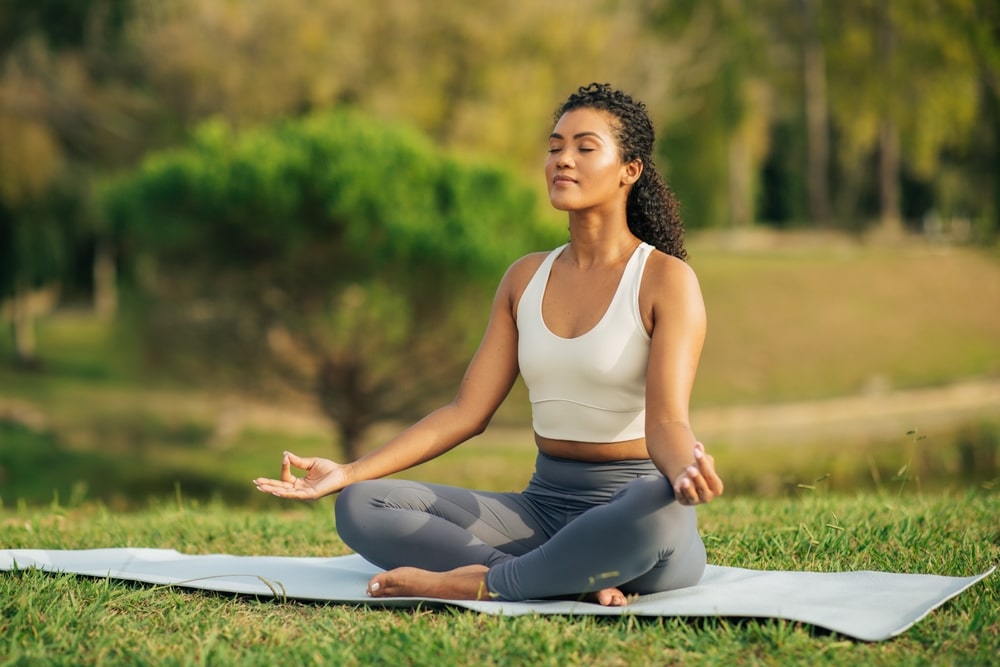Ever noticed how just spending 20 minutes in nature can actually make you feel less stressed? It’s true, scientific studies show that being outdoors can lower cortisol levels and help you feel more at ease. Yet, in our busy, chaotic lives, finding moments of peace can seem almost impossible.
But here’s the good news: finding peace amidst the chaos is possible, and it’s not just a pipe dream. With a few simple, science-backed strategies, you can bring more calm and clarity into your life, even when everything around you feels like a whirlwind.
In this guide, we’ll explore how mindfulness, self-compassion, and setting healthy boundaries can help you stay grounded, no matter what’s happening around you. Keep reading to learn more about finding peace amidst chaos and despair, and discover practical steps to reclaim your calm and clarity even in the middle of the storm.
Contents
- 1 Understanding Inner Peace
- 2 Practical Strategies for Finding Peace
- 2.1 Mindfulness Meditation
- 2.2 Movement Meditation
- 2.3 Anchoring in Nature
- 2.4 Acceptance and Surrender
- 2.5 Setting Healthy Boundaries
- 2.6 Gratitude and Self-Compassion
- 2.7 Breath and Body Awareness
- 2.8 Physical Activity and Movement
- 2.9 Social Connection and Support
- 2.10 Creating a Sanctuary
- 2.11 Energy Healing Treatments
- 3 Establishing a Routine for Serenity
- 4 FAQs: Finding Peace Amidst Chaos
- 5 Final Thoughts
Understanding Inner Peace
Inner peace isn’t simply about avoiding discomfort, but about developing the mental tools to remain calm and centered amid life’s challenges. Understanding this concept deeply is the first step toward cultivating a truly peaceful existence.
Defining Inner Peace
Inner peace, often referred to as “peace of mind,” is a profound state of psychological or spiritual calm that transcends external circumstances. It’s a mental condition that allows individuals to maintain composure, clarity, and emotional balance even in the face of adversity or stressful situations.
Inner peace is not a passive experience; it requires active practice and self-awareness. This state of equilibrium comes from within and is not contingent on external factors like financial stability, relationships, or career success. Instead, it is rooted in cultivating a sense of acceptance, gratitude, and inner balance.
To break it down further, inner peace manifests in a variety of ways. It means being able to process negative emotions, such as anger or fear, without being overwhelmed by them. It’s the ability to make decisions from a place of clarity rather than reacting impulsively due to stress. Most importantly, inner peace allows individuals to experience deep contentment, no matter the external challenges they might face.
How Inner Peace Works in the Brain
From a neurobiological standpoint, inner peace activates the parasympathetic nervous system, which is responsible for the body’s relaxation response. When one practices mindfulness or meditation, for instance, they can train the brain to shift away from the stress-driven fight-or-flight mode and into a state of calm. As a result, chronic stress can be alleviated, leading to clearer thinking, lower anxiety, and better emotional control.
The Importance of Inner Peace
Inner peace plays a pivotal role in maintaining mental and physical well-being, providing a sense of balance that enables individuals to navigate life’s challenges more effectively. It’s not about escaping stress but developing the inner strength to manage it with composure. By cultivating inner peace, individuals experience emotional stability, enhanced resilience, and improved overall health.
- Enhanced Emotional Resilience: Cultivating inner peace strengthens emotional fortitude, allowing individuals to bounce back from challenges with greater ease.
- Improved Emotional Regulation: Inner peace helps manage emotions, reducing impulsive reactions and promoting a more balanced and thoughtful response to stress.
- Better Relationships: It fosters clearer communication, healthier conflict resolution, and stronger, more supportive connections with others.
- Physical Health Benefits: Reduces the harmful effects of chronic stress, lowering the risk of conditions like heart disease and improving overall well-being.
- Facing Challenges with Calmness: Inner peace empowers individuals to approach difficulties with clarity and patience, making it easier to navigate adversity without being overwhelmed.
Practical Strategies for Finding Peace
Implementing specific practices can help foster a peaceful state of mind, even when faced with challenging or chaotic circumstances. These strategies provide tangible ways to reconnect with yourself and the present moment, reducing stress and enhancing emotional well-being.
Mindfulness Meditation
Mindfulness meditation is a focused practice where you sit quietly, close your eyes, and concentrate on your breath, while observing your thoughts without judgment. The goal is to acknowledge the presence of thoughts, emotions, and sensations without becoming entangled in them.
By practicing even for just a few minutes daily, you can interrupt the cycle of stress, allowing your mind to find clarity and remain anchored in the present moment. Over time, this practice enhances your ability to respond to situations calmly, as you train your mind to let go of distractions and return to the moment.
Movement Meditation
Movement meditation, through practices like yoga, tai chi, or mindful walking, encourages a deep connection between the mind and body. These gentle exercises allow you to focus on your movements and breath, helping to center your awareness and quiet the mind.
The slow, deliberate movements reduce physical tension and cultivate an overall sense of mental calm. For example, yoga incorporates intentional breathing with each movement, allowing you to release stress and create a harmonious flow between the body and mind. This practice not only calms the mind but also promotes flexibility, balance, and a greater sense of well-being.
Anchoring in Nature
Spending time in natural environments has profound benefits for mental health. Research shows that just 20 minutes per week spent in green spaces can significantly lower cortisol levels, which are linked to stress.
Nature has a restorative effect, offering a break from the overstimulation of daily life. A mindful walk in the park or simply sitting by a tree allows you to reconnect with the environment, clear your mind, and gain perspective. Nature’s tranquility provides a reset, helping you step back from life’s pressures and return to a state of inner calm.
Acceptance and Surrender
Acceptance and surrender are key elements in achieving inner peace. This practice involves acknowledging the current reality without resisting or wishing for things to be different. It’s about embracing the present moment, including challenges, as part of the journey.
When you stop fighting against what you cannot change, you free yourself from unnecessary stress and emotional turmoil. Surrendering to the flow of life enables you to focus on what you can control, your response, attitude, and actions, while letting go of the need to manipulate every outcome. This mindset fosters a sense of calm acceptance and peace in the face of uncertainty.
Setting Healthy Boundaries
Establishing boundaries is essential for protecting your mental and emotional well-being. By setting clear limits on what you’re willing to accept from others, you prevent burnout and preserve your energy. This can include saying no to obligations that drain you or limiting exposure to negative stimuli, such as excessive screen time or constant news consumption.
Healthy boundaries allow you to create space for self-care and reflection, reducing the overwhelming pressure of external demands. By protecting your personal space, you create an environment where peace can thrive.
Gratitude and Self-Compassion
Practicing gratitude and self-compassion helps shift your mindset from scarcity to abundance. Keeping a gratitude journal and reflecting on the positive aspects of your day cultivates appreciation and strengthens emotional resilience. Equally important is practicing self-compassion, treating yourself with the same kindness and understanding you would offer a friend.
Instead of criticizing yourself for mistakes or imperfections, you acknowledge your challenges with gentleness, allowing for growth without judgment. This practice promotes self-acceptance and supports a peaceful inner dialogue.
Breath and Body Awareness
Breathing exercises like the 4-7-8 technique, along with body awareness practices like body scans, are effective tools for releasing stress and physical tension. The 4-7-8 method involves inhaling for 4 seconds, holding the breath for 7 seconds, and exhaling slowly for 8 seconds.
This technique activates the parasympathetic nervous system, promoting relaxation and calming the mind. Similarly, body scans involve mentally scanning your body from head to toe, identifying areas of tension, and consciously relaxing those areas. Both practices send a calming signal to your nervous system, helping to restore balance and peace.
Physical Activity and Movement
Regular physical activity is a powerful way to support emotional balance and overall well-being. Whether it’s a brisk walk, yoga, or dancing, movement helps release endorphins—chemicals that boost mood and reduce stress. Exercise is also a great way to break out of negative thought cycles and refocus your mind.
Physical activity encourages mindfulness in motion, where your attention shifts from stressors to the rhythm of your body and breath. As a result, consistent movement builds physical and mental resilience, reducing the impact of stress and fostering a sense of calm and accomplishment.
Social Connection and Support
Engaging with supportive friends, family, or community groups provides essential emotional support, helping to lighten your mental load. Sharing challenges and discussing your emotions with trusted individuals can offer valuable perspective, reduce isolation, and strengthen bonds.
Meaningful social connections contribute to a sense of belonging and help you navigate difficult times with greater ease. Whether through face-to-face conversations or virtual support groups, reaching out to others reinforces your emotional resilience and provides a buffer against stress.
Creating a Sanctuary
Designating a personal sanctuary or peaceful space in your home can be a powerful tool for relaxation and inner peace. This could be a corner with comfortable seating, calming lighting, soothing sounds, and elements like plants or essential oils that promote relaxation.
By setting aside a screen-free zone dedicated to rest or reflection, you create a retreat where you can step away from the demands of the outside world. This space serves as a physical reminder of the peace you are cultivating, allowing you to unwind, reset, and recharge in a quiet, nurturing environment.
Energy Healing Treatments
If this is your first time exploring energy healing treatments, it’s important to know that practices like Reiki, acupuncture, or crystal healing can significantly help in balancing your energy and calming your mind. These therapies work by helping to balance your energy field, reduce stress, and encourage physical and emotional healing. By incorporating energy healing into your routine, you can support positive energy flow throughout your body, contributing to inner peace and a more centered, calm state of being.
Establishing a Routine for Serenity
By incorporating mindful practices into your day, you can foster consistent inner peace, reduce stress, and build emotional resilience. A routine provides predictable moments of calm, allowing you to navigate daily challenges with clarity and balance.
Morning Practices
Engage in 5 Minutes of Mindfulness or Breathwork:
Starting your day with 5 minutes of mindfulness or breathwork helps you begin with a centered and calm mind. Focused breathing exercises such as deep belly breathing or the 4-7-8 technique ground you, setting a peaceful tone before you tackle the day. This short practice can reduce morning anxiety, improve focus, and prepare you mentally to face the day’s challenges.
Practice Gratitude Journaling:
Writing down three things you’re grateful for each morning helps shift your mindset from a state of stress or worry to one of appreciation. Gratitude journaling reorients your perspective, enabling you to focus on positive aspects of your life rather than dwelling on potential stressors. This small but powerful habit enhances emotional resilience, boosts mood, and provides a steady foundation of positivity for the day ahead.
Midday Breaks
Take Quick Nature Walks or Perform a Body Scan to Reset:
Incorporating short nature walks or body scans during midday breaks provides an opportunity to release accumulated tension. A 5-10 minute walk outdoors helps clear your mind, reduces stress, and recharges your mental energy. Alternatively, practicing a body scan, where you mentally check in with each part of your body and release tension, can quickly reset your mind and body, preventing the buildup of stress as you continue with your day.
Conduct Boundary Check-Ins:
Midday is a perfect time for checking in with your personal and digital boundaries. Are you feeling overwhelmed by work demands, social media notifications, or personal obligations? Take a moment to assess whether your boundaries are being respected and adjust accordingly. This could mean taking a break from your phone, setting limits on digital communication, or delegating tasks. Regular boundary check-ins ensure that you maintain balance and avoid burnout.
Evening Wind-Down
Incorporate Relaxing Movements Such as Yoga:
To wind down after a busy day, incorporate gentle movements like restorative yoga poses, stretching, or even tai chi. These low-impact activities activate the parasympathetic nervous system, promoting relaxation and preparing your body for restful sleep. Focus on slow, deep breathing as you move through poses to calm both the body and mind, easing away the physical tension that often accumulates throughout the day.
Engage in Reflective Journal Writing or Guided Meditation:
Reflective journaling helps release any lingering thoughts or emotions, providing a sense of closure for the day. Writing about your experiences, challenges, or what you’ve learned can create emotional clarity and prevent the mind from becoming cluttered.
Alternatively, guided meditation, especially before bed, helps calm the mind and prepares it for restful sleep. Guided sessions focusing on relaxation or gratitude can ease anxiety and foster a sense of peace.
Retreat to Your Sanctuary with Soothing Music or Sound:
Create a calming evening ritual by retreating to your personal sanctuary, your designated peaceful space at home. Set the tone for relaxation by playing soothing music or nature sounds, signaling the end of the day and encouraging mental unwinding.
Whether it’s soft instrumental music or ambient soundscapes, these calming sounds help transition your mind from active mode to rest mode, aiding in stress relief and improving sleep quality.
FAQs: Finding Peace Amidst Chaos
What does peace amidst chaos mean?
Peace amid chaos means maintaining mental clarity and emotional balance despite external stress or turmoil. It’s about staying grounded and focused, not by escaping challenges but by learning how to remain calm and centered during them.
How to find peace amidst chaos?
Finding peace in chaos involves practices like mindfulness meditation, setting personal boundaries to reduce stress, and embracing acceptance. These practices help shift your mindset, allowing you to stay grounded and focused even when life feels overwhelming.
What is in between chaos and peace?
The space between chaos and peace is often a state of mental and emotional conflict. It’s when you’re caught in stress or overwhelm but haven’t yet reached calm. Recognizing this transitional phase and using practices like grounding or breathwork can help guide you toward peace.
What role do boundaries play in maintaining peace?
Boundaries are essential for maintaining peace as they protect your mental space. By limiting external demands, reducing stress-inducing stimuli, and carving out time for self-care, boundaries help you preserve your energy, reduce overwhelm, and foster inner calm.
How does gratitude contribute to inner peace?
Gratitude contributes to inner peace by shifting your focus from what’s lacking to what’s abundant in your life. Regularly practicing gratitude helps cultivate a positive mindset, enhance emotional resilience, and promote a sense of well-being, all of which foster inner peace.
Final Thoughts
True inner peace isn’t about escaping chaos; it’s about learning how to respond to it with clarity, compassion, and calmness. Life will always have its challenges, but the key to lasting peace is how you handle them.
By integrating mindfulness, breath control, and movement into your daily routine, you equip yourself with the tools to stay grounded, even in the most turbulent moments. Practices like mindfulness help you stay present and centered, while breathwork can calm your nervous system, making it easier to maintain a sense of calm amidst external stress.
In addition, setting healthy boundaries, whether by limiting digital distractions or saying no to overwhelming demands, gives you the mental space to prioritize what truly matters. Combining these strategies with self-care practices like gratitude journaling, yoga, and time in nature fosters a sense of inner harmony.
By transforming how you respond to stress, you can turn chaotic moments into opportunities for personal growth, resilience, and peace amidst chaos, showing that true serenity comes not from avoiding the storm, but from learning to dance in the rain.




